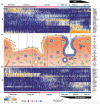Endometrial Receptivity Analysis (ERA): data versus opinions
- PMID: 33880420
- PMCID: PMC8045472
- DOI: 10.1093/hropen/hoab011
Endometrial Receptivity Analysis (ERA): data versus opinions
Abstract
This article summarises and contextualises the accumulated basic and clinical data on the ERA test and addresses specific comments and opinions presented by the opponent as part of an invited debate. Progress in medicine depends on new technologies and concepts that translate to practice to solve long-standing problems. In a key example, combining RNA sequencing data (transcriptomics) with artificial intelligence (AI) led to a clinical revolution in personalising disease diagnosis and fostered the concept of precision medicine. The reproductive field is no exception. Translation of endometrial transcriptomics to the clinic yielded an objective definition of the limited time period during which the maternal endometrium is receptive to an embryo, known as the window of implantation (WOI). The WOI is induced by the presence of exogenous and/or endogenous progesterone (P) after proper oestradiol (E2) priming. The window lasts 30-36 hours and, depending on the patient, occurs between LH + 6 and LH + 9 in natural cycles or between P + 4 and P + 7 in hormonal replacement therapy (HRT) cycles. In approximately 30% of IVF cycles in which embryo transfer is performed blindly, the WOI is displaced and embryo-endometrial synchrony is not achieved. Extending this application of endometrial transcriptomics, the endometrial receptivity analysis (ERA) test couples next-generation sequencing (NGS) to a computational predictor to identify transcriptomic signatures for each endometrial stage: proliferative (PRO), pre-receptive (PRE), receptive (R) and post-receptive (POST). In this way, personalised embryo transfer (pET) may be possible by synchronising embryo transfer with each patient's WOI. Data are the only way to confront arguments sustained in opinions and/or misleading concepts; it is up to the reader to make their own conclusions regarding its clinical utility.
Keywords: embryo transfer; endometrial receptivity; endometrium; implantation / recurrent implantation failure.
© The Author(s) 2021. Published by Oxford University Press on behalf of European Society of Human Reproduction and Embryology.
Figures


Comment on
- doi: 10.1093/hropen/hoab010
References
-
- Adamson G, de Mouzon J, Chambers G, Zegers-Hochschild F, Mansour R, Ishihara O, Banker M, Dyer S.. International Committee for Monitoring Assisted Reproductive Technology: World Report on Assisted Reproductive Technology, 2011. Fertil Steril 2018;110:1067–1080. - PubMed
-
- Altmäe S, Martinez-Conejero JA, Salumets A, Simon C, Horcajadas JA, Stavreus-Evers A.. Endometrial gene expression analysis at the time of embryo implantation in women with unexplained infertility. Mol Hum Reprod 2010;16:178–187. - PubMed
LinkOut - more resources
Full Text Sources
Other Literature Sources
